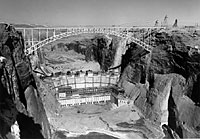Page began as a
construction camp 43 years ago for workers on the giant
hydroelectric project known as Glen Canyon Dam and
Powerplant.
A reciprocal
agreement was made with the Navajo Tribe to transfer 16.7
square miles of Manson Mesa to the Bureau of Reclamation in
exchange for certain desirable lands in southeastern Utah.
 Survey
work began in early 1957 to lay out the streets of the town
then unnamed. It would be given the name of the Honorable
John C. Page who served as commissioner of the Bureau of
Reclamation in the Franklin Delano Roosevelt administration
from 1937-43. Mr. Page died in 1955 without seeing the Glen
Canyon Dam or the town.
Survey
work began in early 1957 to lay out the streets of the town
then unnamed. It would be given the name of the Honorable
John C. Page who served as commissioner of the Bureau of
Reclamation in the Franklin Delano Roosevelt administration
from 1937-43. Mr. Page died in 1955 without seeing the Glen
Canyon Dam or the town.
Workers for the
Glen Canyon Dam first lived in a construction camp on the
west side of the canyon with a footbridge connecting the
east side—700 feet over the Colorado River gorge. As more
construction workers arrived daily, trailers were placed by
the score in rows on the mesa.
Businesses
started arriving. Babbit Brothers Trading Company was the
first supermarket—Page Rexall Drug the first pharmacy. The
Bureau furnished three warehouses for use as school
buildings. They were placed just east of the homes on the
sweeping curve of South Navajo Drive.
Living in early
Page meant no television, poor radio reception and not much
to do so the people made their own entertainment. Dances,
barbeques, 16 mm films and gatherings were popular.
The first movie
theater opened here in 1960 with limited showings during the
week. Hollywood came to Page in 1962 with the filming of
"The Greatest Story Ever Told" and the movie industry
followed that epic with many more films, television
commercials and magazine photo layouts.
Not everything
was peaceful in the early days. Dam construction workers,
seeking higher wages, struck for six months in the summer of
1959. The strike ended on December 24, 1959—Christmas
Eve—and what a joyous Christmas that was for everyone. Work
resumed January 2, 1960, after a new contract was signed.
Page's
population took a downward swing when the dam was completed
in 1963. In would climb up again in 1970 when ground was
broken for the Navajo Generating Station, a coal-fired plant
east of town on the Navajo Reservation.
And a new era
would begin.